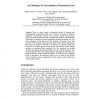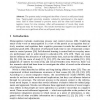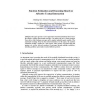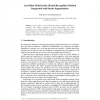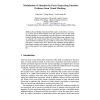ACII
2005
Springer
14 years 5 months ago
2005
Springer
There is a great variety of theoretical models of emotions and implementation technologies which can be used in the design of affective computers. Consequently, designers and resea...
ACII
2005
Springer
14 years 5 months ago
2005
Springer
The present study investigated the effect of mood on self-paced study time. Twenty-eight university students voluntarily participated in the experiment. Half of them listened to po...
ACII
2005
Springer
14 years 5 months ago
2005
Springer
Environment expression is about going beyond the usual Human emotion expression channels in virtual worlds. This work proposes an integrated storytelling model – the environment ...
ACII
2005
Springer
14 years 5 months ago
2005
Springer
This paper presents a novel approach to Emotion Estimation that assesses the affective content from textual messages. Our main goals are to detect emotion from chat or other dialog...
ACII
2005
Springer
14 years 5 months ago
2005
Springer
Abstract. This paper presents research using full body skeletal movements captured using video-based sensor technology developed by Vicon Motion Systems, to train a machine to iden...
ACII
2005
Springer
14 years 5 months ago
2005
Springer
This paper describes a vision-based computational model of mind-reading that infers complex mental states from head and facial expressions in real-time. The generalization ability ...
ACII
2005
Springer
14 years 5 months ago
2005
Springer
In this paper a novel multi-stroke sketch recognition method is presented. This method integrates the stroke segmentation and sketch recognition into a single approach, in which bo...
ACII
2005
Springer
14 years 5 months ago
2005
Springer
In this paper, we present a face alignment system to deal with various poses and expressions. In addition to global shape model, we use component shape model such as mouth shape mo...
ACII
2005
Springer
14 years 5 months ago
2005
Springer
Tracking people using movie sequences is not straightforward because of the human body's articulation and the complexity of a person's movements. In this paper we show ho...
ACII
2005
Springer
14 years 5 months ago
2005
Springer
Abstract. Recent findings demonstrated that negative emotional faces (sad, anger or fear) tend to attract attention more than positive faces do. This study used the paradigm of vis...
